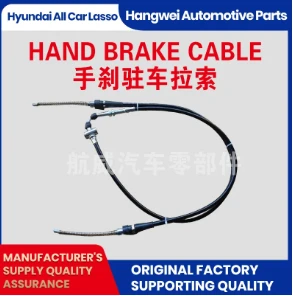Understanding the Function and Maintenance of Car Throttle Cables in Vehicles
Understanding Car Throttle Cables Function, Importance, and Maintenance
The throttle cable is an essential component in a vehicle's engine management system. It serves as the physical link between the accelerator pedal and the engine's throttle body, controlling the amount of air and, consequently, fuel entering the engine. This simple yet vital mechanism plays a crucial role in how effectively a car accelerates and responds to driver input.
The Function of the Throttle Cable
When a driver presses the accelerator pedal, the throttle cable pulls on the throttle body, which opens the airway to the engine. This action allows more air to flow in, enabling the engine to generate more power. In modern vehicles, the throttle control has evolved significantly with the advent of electronic throttle control (ETC) systems. In these systems, the throttle cable may be replaced by an electronic signal sent from the accelerator pedal to the throttle body, which is managed by the engine control unit (ECU). However, many older models still rely on the traditional throttle cable setup, making it vital for the driver to understand its functionality.
Importance of the Throttle Cable
The throttle cable's importance cannot be overstated. It directly affects a vehicle’s performance and responsiveness. A properly functioning throttle cable ensures that the driver experiences a smooth transition of power from the engine. If the cable is too loose, it may lead to a delayed response when pressing the accelerator; if it is too tight, the engine could rev uncontrollably, affecting control and safety.
Moreover, a malfunctioning throttle cable can lead to various performance issues. Symptoms of a failing throttle cable include erratic acceleration, sticky or unresponsive pedals, or unexpected engine revving when trying to maintain a steady speed. These problems can hinder the driving experience and, in some cases, pose safety risks on the road.
Checking and Maintaining the Throttle Cable
car throttle cable

Regular maintenance of the throttle cable is essential for ensuring the longevity and performance of your vehicle. It’s essential to perform periodic inspections to check for signs of wear and tear. Over time, the throttle cable can fray, stretch, or become corroded, especially in harsher driving environments.
1. Visual Inspection Start with a simple visual inspection of the throttle cable for any visible damage or corrosion. Pay attention to the ends where the cable attaches to the throttle body and the accelerator pedal.
2. Functionality Test With the vehicle off, gently pull on the throttle cable while observing the throttle plate. It should move smoothly without any hesitation. If it feels sticky or doesn’t return to its starting position, it might be time to replace the cable.
3. Lubrication In some cases, applying lubricant to the cable can help in maintaining its flexibility and function. Be careful to use the proper type of lubricant, as not all oils are suitable for vehicle components.
4. Replacement If inspection reveals significant wear or if functionality tests fail, replacing the throttle cable is the best course of action. This job can often be done at home with basic tools, but for those unfamiliar with car mechanics, seeking professional assistance is advisable.
Conclusion
The throttle cable may seem like a small component of a vehicle, but its role in engine performance and driver safety is significant. Understanding how it functions and recognizing the signs of a failing cable can lead to better vehicle maintenance and a safer driving experience. Whether you are a seasoned car enthusiast or a casual driver, paying attention to the throttle cable can help you avoid performance issues and unexpected repairs down the line. Regular check-ups and prompt replacements when necessary ensure that your vehicle remains responsive and enjoyable to drive. Ultimately, a well-maintained throttle cable contributes to a smoother ride, enhancing both performance and safety on the road.
-
Workings of Clutch Pipe and Hose SystemsNewsJun.04,2025
-
The Inner Workings of Hand Brake Cable SystemsNewsJun.04,2025
-
The Secrets of Throttle and Accelerator CablesNewsJun.04,2025
-
The Hidden Lifeline of Your Transmission Gear Shift CablesNewsJun.04,2025
-
Demystifying Gear Cables and Shift LinkagesNewsJun.04,2025
-
Decoding Clutch Line Systems A Comprehensive GuideNewsJun.04,2025
